Abstract
Matrimonial property is a form of property division that is practiced by the Malaysian Muslim community based on the custom of people in the
Keywords: Matrimonial PropertySyariah High CourtAlor SetarClaimRates
Introduction
Matrimonial property is one of the rights that can be claimed by both husband and wife whether after divorce, death and polygamy. According to Miszairi Sitiris (2008), there is no definition nor explanation of matrimonial property given by the Islamic scholars in their books. This is because of their custom during their time, only the husbands worked for their families, while the wives managed their household. The issue of matrimonial property did not arise. Contrary to the custom of the archipelago such as Indonesia, Brunei, Patani and also Malaysia, the average population was formerly a farmer. Husband and wife worked together to cultivate their farmland. When they divorced, the property or land they worked together will be divided between them. The case judged by Judge Briggs in 1950 became a clear evidence of the position of a matrimonial property in the local community (Hajjah Lijah Bt Jamal against Fatimah Bt Mat Diah [1950] 16 MLJ 63). Therefore, the matrimonial property is more closely related to the customs practiced in society in this country.
Problem Statement
Generally matrimonial property is a property acquired by husband and wife (Dictionaries Dictionary, 2013). According to Suwaid Tapah (2009), the matrimonial property is the property acquired by the husband and wife during the marriage according to the conditions determined by the Syariah Law. Whereas according to Zaleha Kamaruddin (2009) the matrimonial property can be defined as any movable or immovable property acquired by the spouses directly or indirectly during a legitimate marriage.
Matrimonial property has been enacted in the legislation of the Islamic Family Law in the respective states. Variety of definitions have been given and contained in the Islamic Family Enactment which is generally concluded as property acquired jointly by husband and wife during legitimate marriages and both parties directly or indirectly contribute to the acquisition or possession of such property. In Kedah context, the Kedah Islamic Family Law Enactment (EUKI) 2008 has allocated property acquired by both parties during the period of marriage divided between the two, or ordering the assets to be sold and the proceeds of sale are divided between both husband and wife.
Although there is no affirmation through the Sharia law, the matrimonial property is allowed by the customary law. The custom is permitted by the Sharia Law is a matter of common practice and is often done by them in daily life matters either in words or deeds that are not contrary to the Qur'an and as-Sunnah. According to Jasni Sulong (2008), in the context of Islamic society in Malaysia besides the teachings of the Shafi'i sect, the community also adopts the customary practices accepted by syarak (
Based on this principle, a study should be conducted to examine the reason for a claim of a matrimonial property received by the court in Kedah. Then examine the rates that have been used in Kedah for the couple who have made claims in the court.
Research Questions
The following are the questions of the discussed issue;
Examine the reasons for the matrimonial property claim in Kedah based on cases from 2011-2013.
What are the proportion rates of matrimonial property that exist in Kedah Darulaman?
Purpose of the Study
These are the purposes of this study:
Examine the reasons for the matrimonial property claim in Kedah based on cases from 2011-2013.
Examine the proportion rate of matrimonial property practiced in Kedah based on cases from 2011-2013.
Research Methods
This study uses a qualitative design approach to obtain complete information to fulfil the research objectives. For the data collection purposes, there are two forms of data collection methods that are applied; field research and library research. For field research, the interview method is used to obtain the premier data and it was conducted with the:
Judge of the Syariah High Court
Administrative Officers / Staff of the High Court
Plaintiffs
Mean while the literature study involves samples of the case of a matrimonial property claim recorded at the Syariah High Court of Alor Setar from 2011 to 2013.
All data collected were analyzed using content analysis methods and comparison methods. The two methods of analysis were selected to suit the objectives of the study.
Findings
Reasons for Matrimonial Property Claims in the State of Kedah
Based on the records of the Alor Setar Syariah High Court which are examined through the files of the matrimonial property from 2011 to 2013, there are 3 main reasons for a claim to be made to acquire the matrimonial property which are divorce, death and polygamy. Claims for matrimonial property are made under the section of (SEK) 122, Distribution of Matrimonial Property under the Kedah Islamic Family Law.
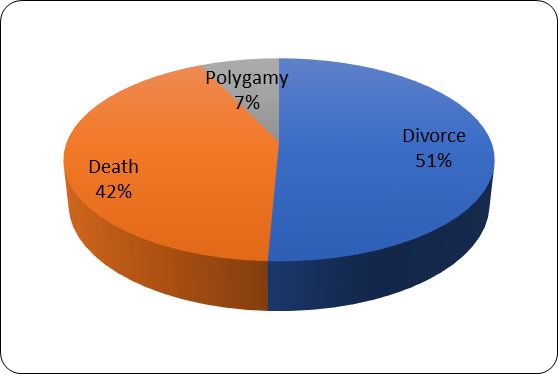
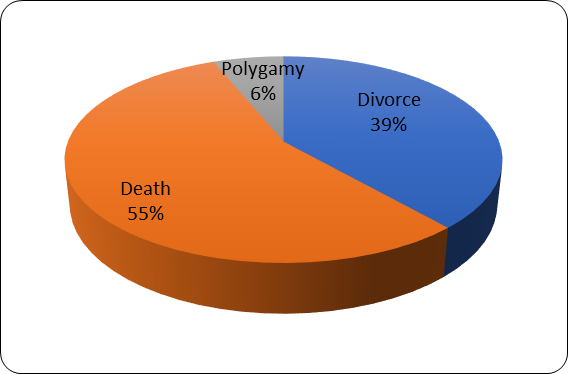
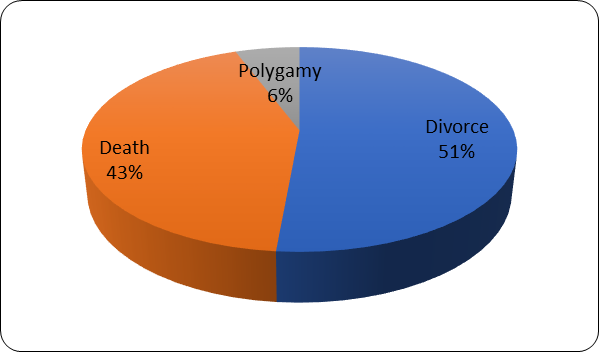
-
Divorce
Divorce generally involves the dissolution of bond, unbinding, liberation and the like (Kamus Dewan, 1997). In terminology, the divorce term means the interruption of marriage or the dissolution of ties based on certain reasons (Wahbah al-Zuhaily, 2010).
Based on the cases of matrimonial property recorded in the Syariah High Court of Alor Setar in 2011-2013, divorce is one of the causes for the demands of a matrimonial property.
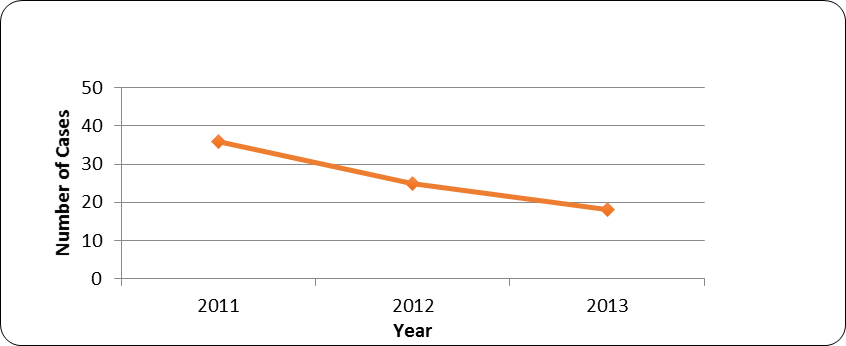
Here are some examples of cases recorded by the Alor Setar Syariah High Court around 2011 to 2013 involving the demands of austerity. The first case that proved divorce was the cause of the matrimonial property claim was between Samsiah Bt Otoh and her former husband, Jaafar Bin Ibrahim. They were married on April 12, 1985 and divorced on October 12, 2010. For almost 30 years they lived on a piece of land with a house at No. 185, Lorong Angsana 1, Taman Angsana, No. Lot PT 3792 Mukim Bandar Kulim. Having divorced, the property is divided equally as a matrimonial property (File No.: 02100-017-0053-2011).
The next case of divorce is between Habshah Bt Abdullah Sani and Zulkifli B Muhamad Hanafiah. The married couple divorced on May 10, 2010. Throughout their marriage they were awarded 3 children. As a result of the divorce the wife or the plaintiff make a claim on the property of the tenant on land Lot No. 7644 Mukim of Parit Buntar, District of Kerian Perak, Land Lot 105 Mukim of Bandar Baru Kedah and 3 buildings on it. They agreed to divide ½ - ½. In addition, there are 2 rent houses, an Usahajaya Company, the income of the Rumah Mesra Rakyat project, the income of Pertubuhan Peladang, a Pajero car, a Honda Prelude, a Kriss motorcycle, 3 lorries, 2 bulldozers. They are evenly distributed at the rate of ½ - ½. The properties other land are plaintiff's. Case closed on July 31, 2012 (File No.: 02100-017-0013-2012).
The next case is Haniza Bt Abd Mohsin's case with ex-husband Anizar B Md Nor. They divorced on February 20, 2013, during their marriage with a child. The wife is the plaintiff or the claimant while the husband is the defendant. Plaintiff claimed for land of Lot PT 1429, Mukim Semeling, Sungai Kroh, Kuala Muda Kedah District which was bought in 1999 as the matrimonial property. Their case went on until March 17, 2013 (File No.: 02100-017-0088-2013).
Through the three chronologically arranged cases have proven clearly divorce is one of the reasons for the demands of matrimonial property.
Death
According to Ibn Manzur (1996), the word death means silence, delusion, calm and immobile. According to Ar-Raghib al-Asfahani (2001), death is a form of spirit separation from the body.
Allah SWT has explained in the Qur'an:
Death is also a cause for the demands of matrimonial property. The analysis made in the Syariah High Court of Alor Setar on cases of the matrimonial property claims clearly proved the matter. According to cases registered in 2011, 30 cases of matrimonial property claim due to death, 35 cases in 2012 and in 2013, 15 cases.
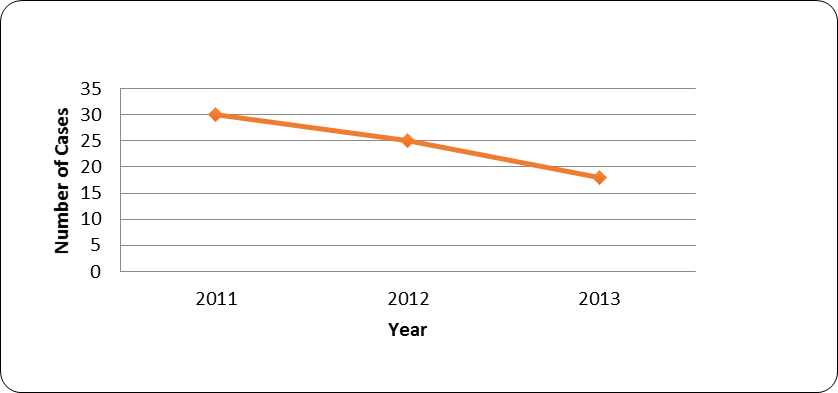
Here are some cases that indicate death is one of the causes of matrimonial property claim. The case that occurred in 2011 when Adzma Bt Fadzil, widow of the deceased Abdul Rahim Bin Hasan, was the plaintiff. Doyah bt Yusuf is the mother of the deceased and in-law to Adzma and her seven sons, Mohd Faaiz, Anis, Adilah, Afizah, Adzni, Azira and Adib are defendants. Adzma was married to Abdul Rahim on July 14, 1985. On April 1, 2001, Abdul Rahim passed away. Throughout the marriage, they have accumulated the following property 1) a semi-detached house at address No. 69, Lorong Semarak 5, Taman Semarak, 08000 Sungai Petani, Kedah. 2) A Proton Saga car with registration number KX 4242. 3) A Toyota Corolla with registration number KBK 3062. 4) A Modenas Kris motorcycle with registration number KBK 3062. 5) A Modenas Kris motorcycle with registration number PFW 2205. 6) A Honda motorcycle with registration number KBE 6519. 7) EPF Fund and Tabung Haji savings. All properties are divided ½ to the matrimonial property and the rest are divided into heirs (File No.: 02100-017-0357-2011).
The next case is between Haslinda Bt Ishak, the widow of Mohd Aswandi. They were married on September 09, 2001. Mohd Aswandi died on April 16, 2012. They had a daughter named Nursyafiqah. Mohd Aswandi has a mother named Ara and 6 younger siblings, Md Noor Hisham, Herolnizam, Mohd Suhaimi, Muhammad Taufiq, Mohammad Nur Firdaus and Nurhidayah. Matrimonial property claimed is the deceased compensation money of RM 87,780.04 in the account of Amanah Raya (File No.: 02200-017-0397-2012).
In 2013, another case of death was the case of Asah Bt Beram, a widow of Man Bin Said. They were married in 1986. The husband died on January 1, 2013. They had a daughter named Satariah Bt Man. The property that was left is BSN savings money of RM 11,280.75. Matrimonial property is ¾ and the rest to the heirs (File No.: 02200-017-0213-2013).
Through these three examples of cases in the current year has shown clearly that death is one reason to matrimonial property.
Polygamy
Polygamy is defined as having more than a wife (Kamus Dewan, 1997). Islam clearly approves polygamy based on verse 3 of Surah Al-Nisa'. In the Islamic family law in Malaysia, polygamy is permitted provided that the husband must obtain written permission from the Syariah Court first. For example, as in the provision in section 23 (1) of the Islamic Family Law (Federal Territories) Act 1984.
Based on the case of a matrimonial property claim in the Syariah High Court throughout 2011-2013, it is clear that polygamy is one of the causes of the claim of matrimonial property. In 2011 5 cases were recorded, 4 cases in 2012 and 2 cases in 2013.
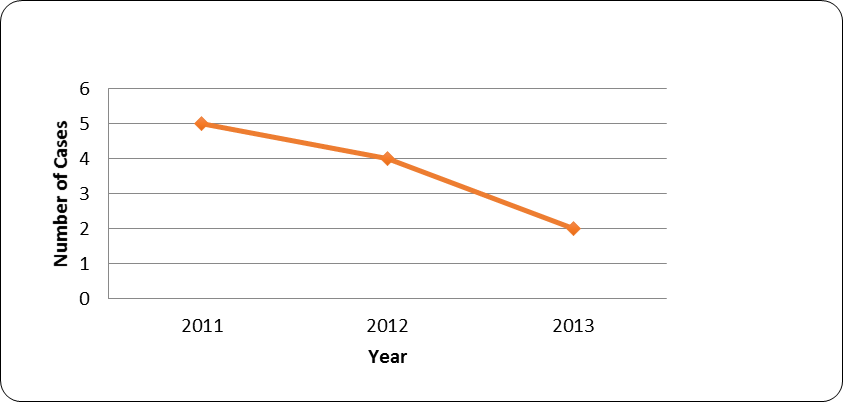
Here are some cases of polygamy which are the reasons for the demands of matrimonial property. The first case is between Bt Mek Saad with the three defendants; Hassan Bin Johari, Harfizi Bin Mohamad Hassan and Nor Silah Bt Hassan. Hassan has polygamy with 4 wives. The first wife, Juriah Bt Hanafi, was the mother of Johari Bin Hassan, who died during confinement. Che Kai's second wife, was divorced while still alive. His third wife, Puteh Bt Arshad, was the mother of Nor Silah Bt Hassan, who left her daughter, Nor Silah when she was 7 months old. The fourth wife, Mek Bt Saad, is the mother of Mohamad Harfizi Bin Hassan. The property claimed is land Lot 1847 and Lot 957. The distribution rate is ½ - ½. (File No.: nil).
Bt Hassan, Mohd Hanif Bin Hassan, Siti Rafiah Bt Hassan, Mohd Salman Bin Hassan and Munirah Bt Hassan. Through mutual agreement on property Lot 6383, 5874 acres (tekai), Lot 7592 an area of 0.8572 hectares tekai, Lot 6033 area of 11,705 square feet tekai, Lot 2992 in an area of 472 jemba has declared as matrimonial property. The rate is ½ to the claimant and ½ to the deceased. For Lot 986, 5 relong 26 jemba, the division is: ¼ to the deceased, ½ part to the second wife Norizan Saad Bt Muhd and the remaining ½ is divided (faraid) to the heirs. For the money in Simpanan Amanah Saham amounting to RM 33,210.50, 1/3 division rate has been divided to the claimant, 1/3 to the second wife and the other 1/3 has been faraid (File No.: nil).
Through these examples of cases according to the specific year, it has proven that polygamy is one of the reasons for the claims of matrimonial property.
Matrimonial Property Distribution Rates in Kedah
In addressing the problem of division of property rates there are several rules have been made. However, these rules still have not been developed to provide a well- structured base for solving the division of matrimonial property. Suwaid Tapah (2009), states that the concept and division of matrimonial property in Malaysia has been enacted in the Islamic Family law in the respective states. The states Syariah High Court have been granted exclusive jurisdiction to hear and speak of the demands of matrimonial property. The rate of claim under the judgment of the Syariah High Court depends on the extent or proportion of contributions granted by the claimant to the property collected during a marriage. The Syariah High Court takes into account the contribution of the spouses directly or indirectly. This division is based on
Matrimonial Property Distribution Rate
The proportion of matrimonial property in Malaysia varies from one state to another. In general, the proportion of matrimonial property distribution becomes difficult because there is no specific provision for determining 1/2: 1/2, 1/3: 2/3, 3/4: 1/4 or the like. The study specializes in rates in the Alor Setar Syariah High Court, indicates the difference according to the clear evidence of the property acquired during the marriage between husband and wife. The rate of acquisition of the property is based on the contribution of the husband and wife. The rate is not set because the Court will take into account several aspects before determining the rate setting either 1/2: 1/2, 1/3: 2/3, 3/4: 1/4.
The cases of matrimonial property claims from 2011 to 2013 found in the Syariah High Court of Alor Setar proved that the rate of division of matrimonial property is at the discretion of the Judge or Qadhi by referring to precedence cases. According to
-
Reason for Claim
The reason for the matrimonial property claim is divorce. Mohd Azi Bin Shafie has pronounced a divorce on Halimah Bt Awang on 18.10.2006. During the marriage they both have 4 children. Claims of matrimonial property is made on 3 properties acquired during their marriage.
Solution Method
The case is dealt with by mutual consent. Based on the case report it is clear that the settlement was made by consensus when there was no dispute between the plaintiff and the defendant.
Matrimonial Property Distribution Rate
The case is resolved by the Court's decision to show the property to be joint property of both: 1/2. This clearly shows the rate of division of the matrimonial property in the Syariah High Court of Alor Setar is 1/2.
Property Type / Contribution Point
The case also indicates that there is an immovable property and two movable property. Immovable property is a terrace house with address No. 30 Taman Aman, Mukim Guar Kepayang, Pendang, while 2 movable property is a Proton Wira car registration number KAW 6879 and a Kancil car registration number PFJ 7689. The plaintiff's claim for the Syariah High Court Alor Setar divides the above assets into two parts . Half handed over to the plaintiff or the claimant and the other half to his ex-husband as the defendant. The contribution of both parties to these assets is a direct contribution. This can be proved when they are together trying to acquire the property.
This case is settled at a rate of 1/2 given to both parties and this proves 1/2 is the rate of claim of the matrimonial property applied in the Syariah High Court of Alor Setar.
-
Cause of Claim
Accoring to the case report, the cause of respective matrimonial property claim case which has been registererd under the 02200-017-0028-2012 reference number, is death. This case of Aishah Binti Zakaria is a widow to Azhar Bin Pawanteh. They were married on 27.04.1986 and were blessed with 4 children, Nur'izzati, Nur'Adlina, Muhammad Hasif and Muhammad Haziq Iman. There are 2 step-children called Mohd Hidzir and Nur Hafizah. Azhar died on 18.08.2011. The deceased left a mother named Charum Bee Binti Md Ali.
Solution Method
This case has been tried under the Sulh Judiciary based on the case report filed. When a case cannot reach a concensus, Sulh will be the mediator for two or more disputed parties.
Matrimonial Property Distribution Rate
The Court has decided all the property involved in the case to be the matrimonial property between the plaintiff , Aishah Binti Zakaria and the deceased, Azhar bin Pawanteh. 2/3 of the parts or value from the buying price of the house RM RM 176,800.00 has been given to the plaintiff and the 1/3 belongs to the deceased has been given to the first defendant, Nur’izzati till the third which is Muhammad Hasif.
Property Type / Contribution Point
While living together, the accumulated assets are as follows, 1 immovable property and 3 movable properties: -
Immovable property
A home addressed No. 122, Lorong KS 2/2, Kulim Square, Lunas, Kulim Kedah. Title No. H.S (M) 800. PT 16551, Mukim Lunas on behalf of Azhar Bin Pawanteh
Movable Properties
A Toyota Unser 1.8GLI (A) Registration Number PFH 9877
A Perodua Kancil EX650, Registration Number PEX 9137
Naza Nando 250 Motorcycle, Registration Number PHP 284
The Syariah High Court of Alor Setar ruled that all the properties in the case to be the matrimonial property between the plaintiff , Aishah Binti Zakaria and the deceased, Azhar bin Pawanteh. 2/3 of the parts or value from the buying price of the house RM RM 176,800.00 has been given to the plaintiff and the 1/3 belongs to the deceased has been given to the defendants.
The verdict is a proof that the rate of division of matrimonial property other than 1/2, 2/3:1/3 has been used in the court to settle the claim of matrimonial property.
-
Cause of Claim
Case reference number 02100-017-0057-201, is a matrimonial property claim because of death and polygamy. This is shown in the case of Azizah Bt Ahmad which is a widow to Ramli Bin Md Noh. They were married on 22.03.1962 and has been blessed with 3 children, Zulkifli, Rohaiza and Rohaini. Ramli had married to the second wife, Faridah Chea Bt Abdullah and had 2 daughters which are Raihan Marini dan Raihan Syamimi.
Solution Method
The case is dealt with by mutual consent. Based on the case report it is clear that the settlement was made by consensus when there was no dispute between the plaintiff and the defendant.
Matrimonial Property Distribution Rate
The plaintiff pleaded the Syariah High Court to rule that the disputed properties to be the matrimonial property between the plaintiff and the deceased, Ramli Bin Md Noh and the plaintiff received 3/4 over the properties and the other 1/4 to be divided (faraid) to the eligible beneficiaries and the parties concerned.
Property Type / Contribution Point
Azizah has filed a matrimonial property claim as Azizah and the deceased has acquired the immovable properties together:-
Lot 1725, Property No. 2165, Bt 4 ½ Jalan Changloon, Mukim Kapelu, Kubang Pasu, Kedah
Lot 14, Property No. 1799, Changkat Jejawi, Mukim Kapelu, Kubang Pasu, Kedah
Lot 1426, GM 31. Padang Besar, Perlis
Lot 3956, GM 2110, Kampung Sena, Mukim Kurung Anai, Perlis
Lot 3957, GM 2111, Kampung Sena, Mukim Kurung Anai, Perlis
As the whole property claimed was the property acquired between the plaintiff and the deceased, Ramli Bin Md Noh, the Court decided that the plaintiff's rate was 3/4 shares on the property and the remaining 1/4 was divided (faraid) to the entitled beneficiary and the parties concerned.
The decision of the Syariah High Court of Alor Setar clearly demonstrates that there is another division rate value of a claim of the matrimonial property of 3/4: 1/4, in addition to ½ and 2/3: 1/3.
Through the analysis of the case files registered at the Syariah High Court Alor Setar from 2011 to 2013, there are three conditions which have been the causes of a claim of matrimonial property. The causes are divorce that occurs in a spouse's relationship, the death of either spouse and a polygamous marriage. An analysis of the contents of each case report found that these three conditions had been given a strong basis by the Syariah High Court of Alor Setar for a claim to be raised.
Whereas in relation to the rate of distribution, based on the case reports and decisions decided by the Judge in the Syariah High Court of Alor Setar, there are three rates which are the solutions to a claim of a matrimonial property which are 1/2: 1/2, 1/3: 2/3 And 3/4: 1/4. This division is made by looking at the evidence and description of the contribution directly or indirectly of both the husband and wife. All three rates have been applied by the Alor Setar Syariah High Court in settling cases throughout the period of study that has been registered in this Court.
Conclusion
Matrimonial property is a form of property jointly acquired by a spouse during the duration of the marriage. This type of property has become the custom of society in Malaysia particularly in Kedah. The existence of this matter has become the basis of the Syariah High Court of Alor Setar to decide on the distribution of property between husband and wife when a matrimonial property claim is due to divorce, death and polygamy. This is done to give and restore the rights between the couple during the marriage period based on the contributions they have given. On this basis, some rates have been decided by the Alor Setar Syariah High Court involving 1/2: 1/2, 1/3: 2/3 and 3/4:1/4.
References
- Al-Zuhaily, Wahbah. (2010). al-Fiqh al-Islami wa Adillatuh. Damsyik: Dar al-Fikr.
- Ar-Raghib al-Asfahani. (2001). al-Mufradat fi Gharib al-Quran. Beirut: Dar al-Ma’rifah.
- Case Reference Number: 02100-017-0013-2012
- Case Reference Number: 02100-017-0053-2011
- Case Reference Number: 02100-017-0057-2013
- Case Reference Number: 02100-017-0088-2013
- Case Reference Number: 02100-017-0357-2011
- Case Reference Number: 02200-017-0028-2012
- Case Reference Number: 02200-017-0087-2011
- Case Reference Number: 02200-017-0213-2013
- Case Reference Number: 02200-017-0397-2012
- Dewan Bahasa dan Pustaka. (2013). Kamus Dewan. Kuala Lumpur: Dewan Bahasa dan Pustaka.
- Hajjah Lijah Bt Jamal verses Fatimah Bt Mat Diah [1950] 16 MLJ 63
- Ibn Manzur. (1996). Lisan al-‘Arab. Beirut: Dar Sadir.
- Sulong, Jasni. (2008). Kedudukan Mazhab Syafi’i Dalam Amalan Pembahagian Pusaka dan Wasiat Islam di Malaysia. Jurnal Syariah. Jil. 16, Bil.1, 163-183.
- Kedah Islamic Family Law Enactment (EUKI) 2008
- Sitiris, Miszairi. (2008). al-Huquq al-Maliyyah lil Mutallaqah (Phd’s thesis). Selangor: International Islamic University Malaysia.
- Tapah, Suwaid. (2009). Konsep dan Amalan Pembahagian Harta Sepencarian. In Akmal Hidayah Halim (Eds.), Undang-undang Harta dan Amanah. Selangor: International Islamic University Malaysia.
- Kamaruddin, Zaleha. (2009). Hukum Harta Sepencarian Dari Sudut Pandangan Wanita Peneroka FELDA. In Akmal Hidayah Halim (Eds.), Undang-undang Harta dan Amanah. Selangor: International Islamic University Malaysia.
Copyright information

This work is licensed under a Creative Commons Attribution-NonCommercial-NoDerivatives 4.0 International License.
About this article
Publication Date
31 December 2018
Article Doi
eBook ISBN
978-1-80296-051-8
Publisher
Future Academy
Volume
52
Print ISBN (optional)
-
Edition Number
1st Edition
Pages
1-949
Subjects
Company, commercial law, competition law, Islamic law
Cite this article as:
Dahaman@Dahlan, M. A. B. D., Nawawi, K. B., & Diah, M. F. B. M. (2018). Matrimonial Property: The Causes Of Claim And Distribution Rate. In A. Abdul Rahim, A. A. Rahman, H. Abdul Wahab, N. Yaacob, A. Munirah Mohamad, & A. Husna Mohd. Arshad (Eds.), Public Law Remedies In Government Procurement: Perspective From Malaysia, vol 52. European Proceedings of Social and Behavioural Sciences (pp. 462-474). Future Academy. https://doi.org/10.15405/epsbs.2018.12.03.46

